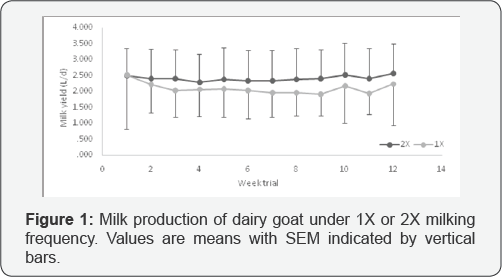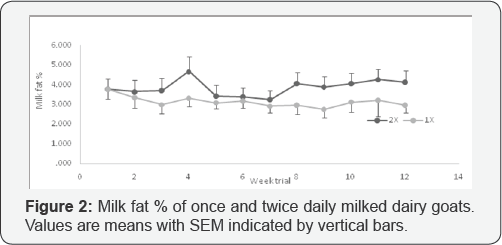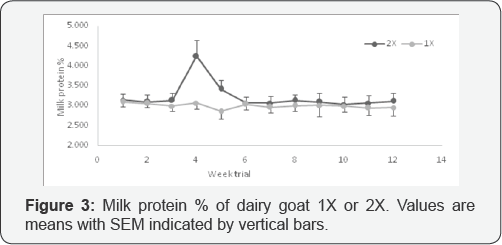Effects of Milking Frequency of Dairy Goats on Milk ||| Yield and Composition and on System Profitability-Juniper Publishers
Journal of Dairy & Veterinary Sciences- Juniper Publishers

Introduction
Intensive and semi-intensive dairy farms invest in
automatic milking systems motivated by increased milk production per
goat. Milking frequency is an important factor determining milk yield
and quality of dairy goats that requires adequate feeding, welfare,
health and environmental conditions [1].
The potential advantage of increased milking frequency for milk
production and composition used to be main reason for applying this kind
of management; nowadays, however, the production model that takes
priority is one known as "low cost, high return"[1].
Since more frequent milking requires more variable costs, knowledge
about the real increment of production per goat under a double milking
system is necessary to decide if this practice will be adequate for each
dairy system. For the twice daily milking frequency, increases in milk
production of 6-18% were reported for native Spanish goat breeds like
Majorera, Murciano Granadina or Tarirfena [2-4]. In Swiss breeds like Saanen and Alpine variable increments from 17 to 36% were documented [2,5,6].
The reported wide variation in milk yield may be attributed to
different factors, such as breed, lactation stage, production level, and
intervals between twice milking.
During intervals between milking, milk is stored in
the lumen of alveoli, milk ducts, and udder cisterns. There are studies
about the effect of twice (2X) vs. once (1X) milking a day on chemical
composition of different milk fractions [4,7,8]; however, changes in the composition of the whole milk have been poorly studied. Torres et al. [8]
indicated that fat content was the only milk component that presented
variation with different milking frequency (3.86 once and vs. 4.38%
twice daily). Nevertheless, total solids percentage was not modified.
Salama et al. [4]
also reported changes in fat content, with the lowest percentage being
obtained with twice daily milking (5.10 vs. 4.62%). As a consequence,
they concluded that animals subjected to this milking frequency
presented a lower percentage of total solids.
The objective of the present study was to determine
the effects of two milking frequencies (once vs twice daily) on milk
yield and chemical composition of multiparous Saanen biotype goats
during the second third of lactation under the northwestern Argentina
system conditions.
Materials and Methods
Thirty-six third or more parity Saanen goats with
90±5d in milk born and reared at the National Institute of Agricultural
Technology of Salta province, Argentina, were used for the present
trial. Animals were allocated to the treatments (1X: once daily
milking-2X: twice daily milking) based on average milk production of the
first 90 days of lactation. Milking frequency before the experimental
period was once daily. The experiment was conducted during 12wk; goats
were milked at 0500h (1X) or at 0500-1700h (2X). The animals had access
to alfalfa pasture during milking intervals (0800-1630) and grazing
management consisted of the allocation of daily plots by visual
estimation of the availability of forage dry matter (2000kg/DM/ha).
At the milking parlor, goats received 600g/animal/d
of corn and 20g/animal/d of a vitamin-mineral corrector. Goats milked
twice daily received the same ration but offered at two different
moments of the day. Before the experiment, goats were allowed 1wk of
adaptation to milking frequency Milk yields of individual goats were
measured with an Mk 5 Waikato milk meter (direct measurement device;
Waikato, Hamilton, New Zealand) every day during the 84 days of trial
(12wk). Individual samples were taken once a week to measure milk
composition (percentages of fat, protein, lactose, nonfat solids, ash).
Milk samples (100ml) were obtained from the Waikato meters in the
morning (1X) and in the evening and following morning (2X) milking
treatments and were analyzed using the Lactostar Funke Gerber automatic
analyzer.
Statistical analyses were performed using PROC MIXED
of SAS (version 9.0; SAS Institute Inc., Cary NC). The model included
fixed effects of milking frequency and week of trial and their
interactions. Differences between milking frequencies were evaluated
using a Tukey test. Statistical differences were considered significant
at P<0.05.
Result and Discussion

1 SEM: standard error of the mean.
24% FCM= 0.4(L of milk) + 15 (kg of fat).
Means with a different letter within the same row are different (P<0.05).
The results of the trial are shown in Table 1.
Milking frequency treatments resulted in different milk yields between
once and twice daily milking groups, but no differences were obtained
between weeks. Figure 1
shows the evolution of mean milk yields throughout the trial. Although
the trial began on day 90 post-partum, i.e. in the second third of
lactation, 2X obtained 19.61% more milk daily than 1X; this percentage
suggests an important difference considering the decrease in milk yield
that occurs in the lactation curve from day 90 post-partum. However,
other previous trials that began on the first post-partum days and that
involved different goat breeds demonstrated similar differences, such as
18% with Murciano-Granadina [9] and 8-35% with Alpine [6], and even a lower percentage (9.3%) with Tinerfeña [3].

Milk yield is a function of two factors that change
during the course of lactation: the number of mammary secretory cells
and their metabolic activity. The rate at which they change may be
influenced by farm management practices, such as milking frequency [10].
It has been suggested that once daily milking stimulates an
accumulation of Feedback Inhibitor of Lactation (FIL) in the
milk-producing alveoli, resulting in feedback inhibition of milk
synthesis and secretion. Furthermore, frequent removal of milk (2X) from
the gland minimizes local inhibitory effects of FIL and increases milk
secretion [9-11].

Results of milk composition showed that twice daily milking increased milk fat percentage significantly (Figure 2), with values differing between weeks (Table 1). Capote et al. [3,4]
found that goats milked twice daily showed a significant increase in
fat percentage compared with those milked once daily due to a higher
proportion of alveolar milk removed in goats under the former frequency,
which is richer in fat. These results were in disagreement with those
found by Salama et al. [4],
who reported that milk of 1X goats were more concentrated than milk of
2X goats (fat: 5.10 vs. 4.62%, and casein 2.57 vs. 2.35%).

Milk protein percentage varied significantly between
treatments and was greater in all weeks in 2X milked goats (Figure 3).
In contrast, Salama et al. [4] and Capote et al. [7] did not find differences in milk protein content due to milking frequency, whereas Boutinaud et al. [5] showed a higher protein content in Saanen goats milked X1 than in X2 and X3 milked goats.
Total solids did not show significant differences between X1 and X2 milked goats (Table 1). Salama et al. [4]
reported greater total solids for X2 (13.6 vs. 12.9%). Milk total
solids are a mixture of fat, protein, lactose and mineral matter. Thus,
variations in these components can affect their concentration. In the
present work, although milk fat was the most variable component between
milking times, total solids percentages were not affected.
An important point in goat dairy system is profitability. In agreement with Salama et al. [4], Komara et al. [7] and Capote et al. [7],
the present results showed on average 17.4% yield increase using twice
daily milking. This gain in yield would not justify the change of system
in the milking routine. For example, in Argentina the daily cost of
energy, milking machine service and spare parts, labor, detergents,
antisepsis and time spent for the second milking increase the costs by
66.4% over once daily milking. The milk yield increase obtained from the
present trial (19.6%) is far from covering and validating the
difference in daily expenditures.
Another advantage to be considered is the working
time that can be saved; dairy farmers always want to reduce their labor
time to assign it to other activities and high labor costs make it
impossible to take supplementary staff. Once-daily milking offers the
possibility to reduce the work of dairy farmers because, for example, in
French dairy cow farms the time spent milking in twice-daily milking
represents about 50% of the daily labor time6. In the case of dairy goat
farmers, this amount of time is allocated to manufacture and sell goat
milk cheese [12-14].
Conclusion
This study demonstrates a moderate to low increase in
milk yield and quality under twice daily milking during the second
third of lactation in two liters-yielding Saanen goats. Under Argentina
economic conditions, this management strategy, besides consuming more
time, is not profitable for dairy goat farmers. Nevertheless, further
investigations should be carried out to assess the magnitude of milk
yield gains if twice daily milking is practiced during the first third
of lactation of young and older goats.
Ethics statement
The procedures adopted has been approved by the
Ethical Review Committee (CICUAL: Institutional Committee of Care and
Use of Experimental Animals) of the University of La Plata, Argentina.
There was no animal experimentation involved apart from normal system of
goat production and our veterinary intervention.
To know more about journal of veterinary science impact factor: https://juniperpublishers.com/jdvs/index.php
To know more about Open Access Publishers: Juniper Publishers


Comments
Post a Comment